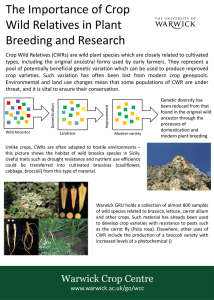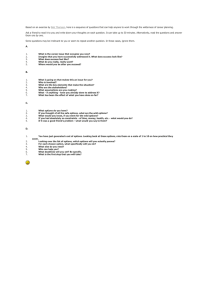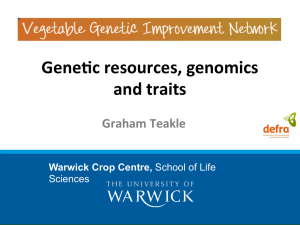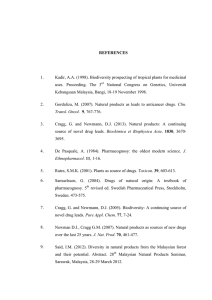Pecha Kucha Graham Teakle The use of wild species for crop improvement:
advertisement
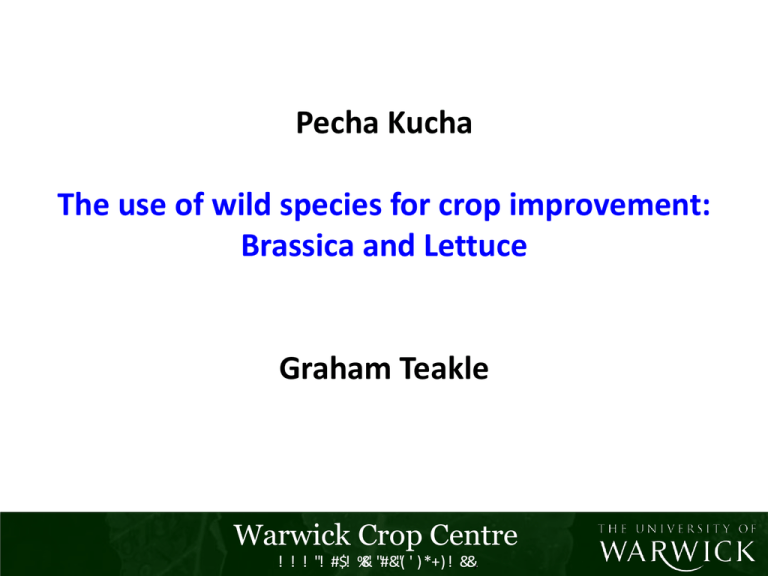
Pecha Kucha The use of wild species for crop improvement: Brassica and Lettuce Graham Teakle Warwick Crop Centre ! ! ! "! #$! % &' "#&"( ' )*+)! &&, Pests and diseases Cabbage root fly Lettuce downy mildew Currant lettuce aphid Diamond-back moth Diamond-back moth caterpillar damage Agrochemicals Breed varieties that require less inputs • Less fertiliser • Genetic resistance to pests and disease Sources of genetic variation • Other varieties • Genebanks But often can’t find required traits The breeding genepool of crops generally has a narrow genetic base compared to the wider species genepool Species Genepool Selection during Domestication Crop Genepools B F F F D A D G C E E B F B G B E B C F Crop type 1 (e.g. Cauliflower) C A F F C D A F A C Crop type 2 (e.g. Broccoli) C F G C E E C D D C Crop type 3 (e.g. Cabbage) Cytoplasmic diversity in C-genome B. species 6 chloroplast SSRs used to type 171 individuals of 10 C-genome Brassica species No. Accessions Tested No. Chloroplast haplotypes H* B. bourgaei 1 1 - B. cretica 9 6 0.74 B. hilarionis 4 2 - B. incana 11 2 0.17 B. insularis 4 3 - B. macrocarpa 16 4 0.41 B. montana 3 1 - B. oleracea 105 4 0.07 B. rupestris 4 3 - B. villosa 13 6 0.78 Species *H (diversity index) – only calculated where nine or more accessions tested Majority are from BolDFFS SNP s on the Wild C genome DFFS Oleracea (21) 0.3 Montana(4) Macrocarpa (17) 0.2 Cretica (8) Bourgaei (1) Coordinate 2 0.1 Insularis (2) 0 Atlantica (2) Incana (10) -0.1 Alboglabra (1) -0.2 Hilarionis (2) Rupestris (4) -0.2 -0.1 0 0.1 0.2 Coordinate 1 0.3 0.4 0.5 Villosa Wild species relatives How edible are wild species? Challenges to using wild species • Getting plants to flower • Fertile hybrids with crop varieties • Identifying useful traits • Getting rid of traits you don’t want Wild C genome species diversity set Founder plant x RC B. oleracea F1 Microspore culture Doubled haploid lines No. founde Species accession B. alboglabra 1 B. atlantica 2 B. balaerica 1 B. bourgei 1 B. cretica 8 B. hilarionis 3 B. incana 10 B. insularis 2 B. macrocarpa 16 B. maurorum 1 B. montana 3 B. oleracea 24 B. rupestris 4 B. villosa 13 Total - 14 species 88 Genotype 89 Founder Lines SNP marker analysis of Brassica C genome DH lines C10032 C10041 C10043 C10048 C1 C2 C3 C4 C5 C6 C7 C8 C9 C1 C2 C3 C4 C5 C6 C7 C8 C9 C1 C2 C3 C4 C5 C6 C7 C8 C9 C1 C2 C3 C4 C5 C6 C7 C8 C9 AGSL150 genotype – blue; C04001 genotype – red 0 CDH16 CDH40 CDH08 CDH27 CDH15 CDH11 CDH07 CDH26 CDH03 CDH47 CDH46 CDH33 CDH29 CDH41 CDH09 CDH14 CDH50 CDH49 CDH12 Skywalker CDH38 CDH37 CDH10 CDH05 CDH52 CDH36 CDH43 CDH01 CDH42 CDH19 CDH17 CDH13 CDH04 CDH28 CDH25 CDH02 CDH06 CDH44 CDH45 CDH30 CDH39 CDH35 CDH18 CDH20 CDH34 CDH51 CDH48 20 CDH24 15" CDH31 16" CDH21 Best Bol DFFS Bol14" Bol46" Bol19" Bol32" Bol12" Bol16" Bol20" Bol25" Bol21" Bol47" Bol04" Bol28" Bol41" Bol34" Skywalker" CDH01" Bol09" Bol26" Bol01" Bol15" Bol18" Bol42" Bol48" Bol49" Bol10" Bol24" Bol05" Bol11" Bol31" Bol43" Bol39" Bol36" Bol45" Bol23" Bol06" Bol08" Bol29" Bol33" Bol40" Bol44" Bol35" Bol07" Bol17" Bol37" Bol30" Bol38" Bol03" Bol02" Bol22" 0" CDH23 25 CDH32 Best CgDH line CDH22 Diamond Back Moth resistance screening 17" Number larvae - B. oleracea 14" 13" 12" 11" 10" 9" 8" 7" 6" 5" 4" 3" 2" 1" Number of larvae - wild species 15 10 5 0 95 96 14 85 87 92 22 62 93 84 2 1 71 38 37 54 60 8 57 9 61 64 40 5 32 51 16 10 24 68 70 15 42 17 81 59 36 77 73 43 56 7 35 27 34 63 21 29 58 44 3 86 28 25 12 4 13 26 75 74 88 11 90 91 31 89 23 33 67 30 69 18 78 79 49 82 19 39 41 47 48 50 83 45 76 52 80 46 6 53 72 94 66 20 55 65 Mean N. ribisnigri count Identifying resistance to Lettuce-currant aphid (Nasonovia ribisnigri) 400 350 300 250 200 150 100 50 Lettuce DFS line Mapping traits of interest • Making segregating populations to perform mapping Linked genetic markers used in breeding • Select gene of interest • Remove undesirable alleles resulting from linkage drag Summary • Wild species are an underexploited resource for new traits • There are a number of significant challenges to their utilisation • At Warwick we are developing the capability to effectively do this through: New genetic resources Phenotyping techniques Genomics to identify the genes
